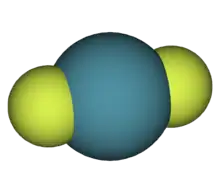Radon difluoride
Radon difluoride (RnF
2) is a compound of radon, a radioactive noble gas. Radon reacts readily with fluorine to form a solid compound, but this decomposes on attempted vaporization and its exact composition is uncertain.[1][2] Calculations suggest that it may be ionic,[3] unlike all other known binary noble gas compounds. The usefulness of radon compounds is limited because of the radioactivity of radon. The longest-lived isotope, radon-222, has a half-life of only 3.82 days, which decays by α-emission to yield polonium-218.[4]
 | |
| Names | |
|---|---|
| IUPAC name
Radon difluoride | |
| Other names
Radon(II) fluoride | |
| Identifiers | |
3D model (JSmol) |
|
| |
| |
| Properties | |
| RnF2 | |
Except where otherwise noted, data are given for materials in their standard state (at 25 °C [77 °F], 100 kPa). | |
| Infobox references | |
Preparation
When radon is heated to 400 °C with fluorine, radon difluoride is formed.[1]
Reactions
Randon difluoride can be reduced back to radon to form hydrogen fluoride when heated with hydrogen gas at 500 °C.[1]
References
- Fields, Paul R.; Stein, Lawrence; Zirin, Moshe H. (1962). "Radon Fluoride". Journal of the American Chemical Society. 84 (21): 4164–4165. doi:10.1021/ja00880a048.
- Stein, Lawrence (1970). "Ionic Radon Solution". Science. 168 (3929): 362–4. Bibcode:1970Sci...168..362S. doi:10.1126/science.168.3929.362. PMID 17809133. S2CID 31959268.
- Pitzer, Kenneth S. (1975). "Fluorides of radon and element 118". J. Chem. Soc., Chem. Commun. (18): 760b–761. doi:10.1039/C3975000760b.
- Stein, Lawrence (1987). "Chemical Properties of Radon". Radon and its Decay Products. ACS Symposium Series. 331. pp. 240–251. doi:10.1021/bk-1987-0331.ch018. ISBN 978-0-8412-1015-8.
This article is issued from Wikipedia. The text is licensed under Creative Commons - Attribution - Sharealike. Additional terms may apply for the media files.